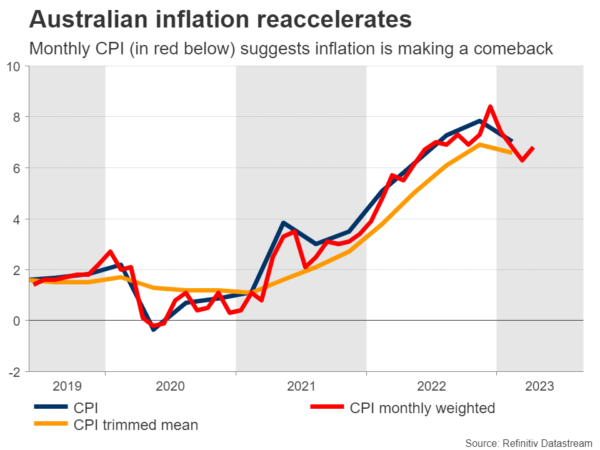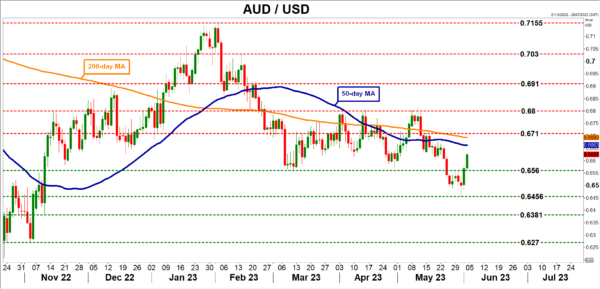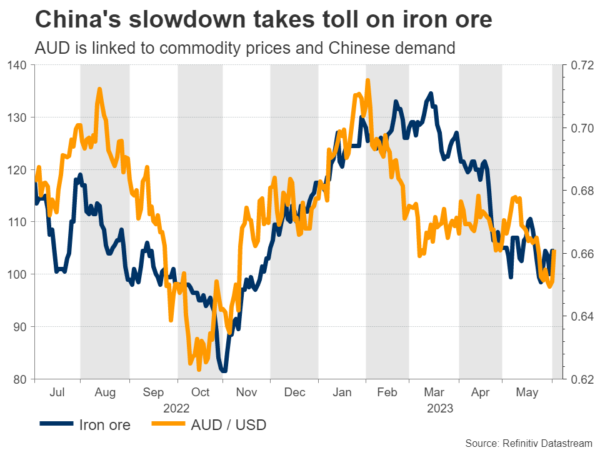The Reserve Bank of Australia will announce its next rate decision at 04:30 GMT on Tuesday. Markets are pricing in a 45% probability for another rate increase, as inflation has been hotter than anticipated lately. If the RBA raises rates, the Australian dollar could benefit, although it’s questionable whether the currency can sustain a rally with the Chinese economy losing steam.
Hotter inflation, slower growth
It will be a difficult decision for Australian central bank officials next week, as there are solid arguments both for raising interest rates and for pausing. The prospect of another rate increase is supported mainly by the recent trend in inflation.
After several months of declines, inflation fired up again in April and is currently on track to overshoot the Reserve Bank’s forecasts for this quarter. Similarly, the latest quarterly data on wages showed an acceleration, fanning concerns of a wage-price spiral that keeps inflation burning for some time.
Reinforcing such concerns was this week’s decision by the Fair Work Commission to raise the minimum wage by 5.75%, providing another boost to wage growth that could lead the RBA to adopt a more aggressive stance.
However, other elements suggest the RBA should take a cautious approach and do nothing next week. The labor market weakened in April, with the unemployment rate rising noticeably. Meanwhile, retail sales stagnated as consumers turned more defensive. Combined, these suggest economic growth has started to lose momentum.
Similarly, the slowdown in China’s manufacturing sector continues to intensify, which spells bad news for an Australian economy that relies on Chinese demand to absorb its commodity exports.
RBA decision is a close call
Hence, the question heading into next week’s rate decision is whether the RBA will prioritize fighting inflation or supporting economic growth. So far, policymakers have been laser-focused on bringing inflation down, and with inflationary forces regaining strength, it will be hard for the RBA to do nothing.
Markets are pricing in a 45% probability for a quarter-point rate increase, which seems relatively low considering the inflation dynamics. Nonetheless, a rate hike is almost fully priced in by July, so traders are betting it’s only a matter of time before the RBA hits the tightening button again.
Since investors view this decision as a coin toss, there is scope for the Australian dollar to gain if rates are raised. From a chart perspective, any advances in aussie/dollar could encounter initial resistance around the 0.6710 zone, which roughly encapsulates the 200-day moving average, currently at 0.6694.
On the flipside, if the RBA pauses and signals it will be patient while it examines incoming data, the pair could resume its downward trajectory, turning the spotlight towards the 0.6560 support region.
Rallies might be short-lived
Looking beyond this meeting, the trajectory in the Australian dollar might depend mostly on how the Chinese economy evolves in the coming months, and how global risk sentiment fares.
Admittedly, it’s tough to be optimistic about the aussie when Chinese demand is rolling over and commodity prices are struggling, against the backdrop of slowing global growth. The charts tell a similar story as the aussie has been trapped in a downtrend for over two years now.
One potential game-changer for the aussie would be an announcement from China that serious stimulus measures are on the way. This has been widely speculated, as it seems almost impossible for Chinese authorities to hit their growth targets without juicing up the economy.
A deluge of Chinese stimulus would be good news for the aussie, but whether it will be enough to turn the tide for good is another question. Ultimately, that might depend on the scale and scope of any measures.
Note that GDP growth numbers for Q1 will be released Wednesday, after the RBA meeting.
















